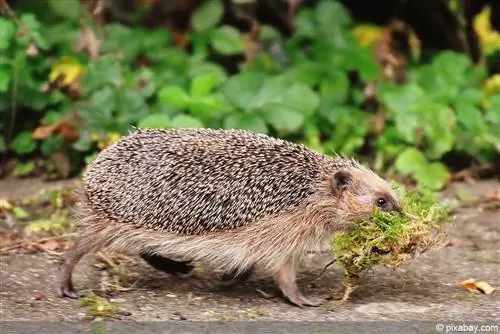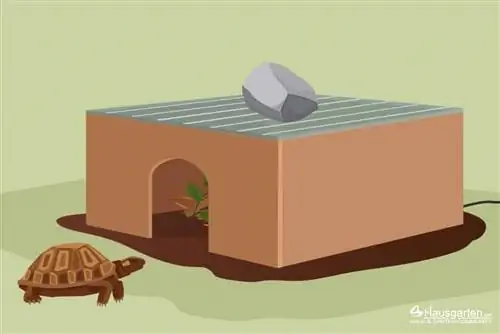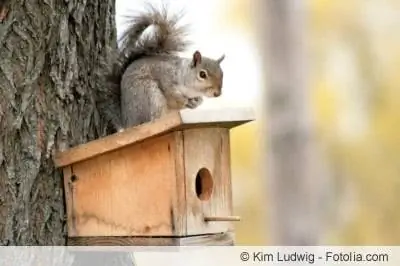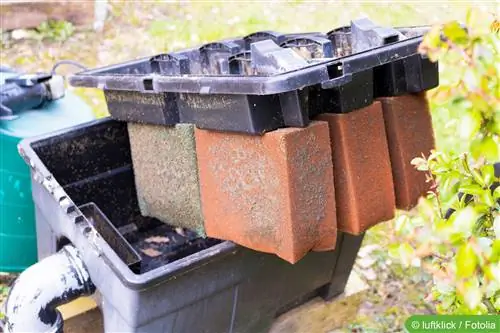- Author admin [email protected].
- Public 2023-12-17 03:39.
- Last modified 2025-01-24 12:45.
With the following instructions it will be fun to build and furnish a hedgehog house yourself. You can choose whether it will be a very entertaining pleasure or whether it will be a “hedgehog villa” that only experienced DIY enthusiasts can achieve perfectly:
Hedgehog House No. 1: The Invisible Brick Building
If you currently need a hedgehog house in the garden, but are not an avid do-it-yourselfer and don't plan on becoming an avid do-it-yourselfer: Anyone can build this hedgehog house, as it is simply piled up. Which has the additional advantage of reducing construction time to a minimum.
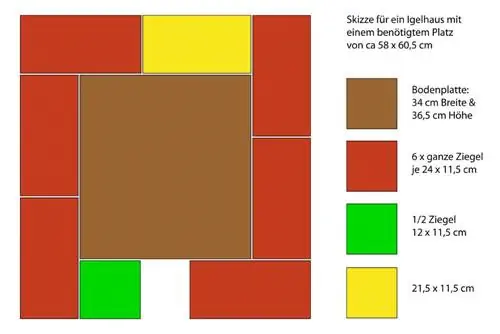
You don't need much material either:
- 30 bricks, current German standard format (NF), 24 long, 11.5 wide, 7.1 high
- Wooden board or concrete pavement slab as a roof, larger than the floor slab and not much larger than the entire floor plan
- Ev. Base plate 34 x 36.5 cm
- Cut-off machine
- odorless roofing felt or foil
- Straw, dry leaves
How to build the “hedgehog house quickly and easily”:
- Cut a piece of cardboard measuring 34 x 36.5 cm as a placeholder for the interior
- Place the placeholder on the floor at the desired location
- Pile the bricks around the placeholder
- Lay out 7 stones per layer, 1 in 4 layers
- Step the stones in the 2nd layer offset to layer 1
- And the stones of the 4th layer are moved to layer 3

- Of the normal format bricks (24 x 11, 5 x 7, 1), 4 need to be shortened by 2.5 cm
- They will be inserted in the color-coded areas at the back
- Necessary so that the entrance is only 10 cm wide (good for hedgehogs, bad for cats and birds of prey)
- 4 layers in height - base plate results in approx. 30 cm (calculated with mortar), a sufficient height for hedgehogs
- A wooden board or a concrete paving slab are suitable as a “quick roof”
- The pavement slab does not extend over the entire width of the stone, which is irrelevant because of the cladding of the hedgehog house presented below
- The wooden board can be cut to size
- A 60×60 cm plate also works, a little overhang at the entrance is rather positive
- However, wood must be impregnated with substances whose smell does not bother hedgehogs (see tip)
- When the hedgehog house is standing, the interior can be furnished nicely and comfortably
- Straw and/or dry leaves are suitable for this
- Which should simply be scattered and not arranged until they have taken on the human smell
- If necessary, replace the placeholder cardboard with a floor board, see below
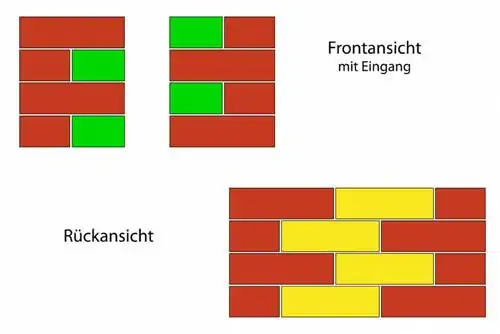
When the actual house or "inner house" is in place, the highlight of this hedgehog house comes: It is wrapped so nicely all around that the hedgehog sleeps with heat and noise insulation and the hedgehog house looks like a small green hill and natural part from the outside of the garden works. To do this you need soil, grass and moss patches, brushwood, possibly garden netting or rabbit wire for attachment and a little artistic skill. If the artificial hill looks a little wild at the beginning, that shouldn't bother you - as the grass and moss grows, the individual parts come together.
Hedgehog House 2: The pretty, comfortable wooden bungalow
This wooden house is the option for all do-it-yourselfers who like to work with their hands, but also like to finish it at some point.
Material list:
- 5 or 6 approx. 30 x 30 cm wooden boards for walls, roof and possibly floor, there is a separate paragraph below
- The board for the roof can be a little bigger
- Screws or nails for joining together
- Jigsaw
- Odorless roofing felt or foil
- Environmentally friendly, odorless water protection glaze
- Straw, dry leaves
Construction of the hedgehog house:
- Make all boards waterproof with environmentally friendly glaze
- Let the wood dry thoroughly in a warm interior
- Saw an opening of approx. 10 x 10 centimeters in one of the wall boards
- This entrance allows hedgehogs through, but not cats
- Join walls and possibly floors with screws or nails
- Put the roof on and fasten it
- The roof can protrude a little towards the front, this protects against moisture penetration
- To prevent moisture from above, a piece of roofing felt or a tolerable colored film can be nailed on
- Pad the floor of the finished hedgehog house with straw or dry leaves
If the hedgehog house is on the prepared place, it can also be covered again, e.g. B. with excavation (see soil). You can also use bark mulch, straw and brushwood from fine branches to cover; The purpose is to provide additional protection against the cold and to protect the hedgehog from curious pets. In autumn and winter, a lot of leaves on the hedgehog house are a good thing, so the artificial building finally becomes a natural nesting and overwintering place.
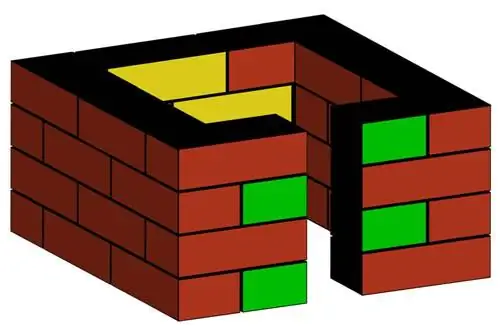
This hedgehog house takes a little more time than the brick layer construction, but it is within reasonable limits. Ambitious do-it-yourselfers can of course find completely different instructions on the Internet, including mortised masterpieces with complicated inner workings. The hedgehog doesn't care which design it should move into, it will hibernate in the brick building and also in the wooden house, even if you recreate the Burj Khalifa or the Allianz Arena in wood in the upper area. But it doesn't matter to him as long as the structure in the lower area corresponds exactly to the specifications and in the upper area it doesn't look too unnatural (no one will be able to predict where the limit is for hedgehogs). A completely different argument against “magnificent buildings” could be that admirers of the architecture have to remain as quiet as a mouse in order not to bring the hedgehog out of hibernation.
Tip:
Enthusiastic do-it-yourselfers often want to opt for a wooden bungalow straight away because piling up bricks doesn't satisfy their ambition. But be careful: the wooden bungalow must be made water-repellent. And the great boat paint from the basement that you have already had good experiences with is not necessarily suitable for this. Much of what is offered in the hardware store under “wood protection for outdoors” is likely to stink to hedgehog noses, so that the hedgehog house would remain empty with such a coat of paint (including products with environmental awards). If you work with wood, you should ask the nearest hedgehog station or a nature conservation organization to find out which of the paints currently on the market has already been tested as “hedgehog-friendly”. Recommendations in building instructions are often not up to date as changes are constantly being made in this product area.
The location for the hedgehog house
The children would like to check every day to see whether the hedgehog is doing well - but since they shouldn't do exactly that under any circumstances, the hedgehog house should best be placed in the last corner of the garden (where possible quickly no longer becomes the focus of attention).
Otherwise it is important not to choose a depression in which the water collects. If present, rather the opposite: a small hill from which even the strongest rule can quickly flow away without “taking the hedgehog and his house with him”. And the place should not be on the weather side (or with the slip towards the weather side), where any rain and wind becomes unpleasant.
A good spot offers some protection from the rain from above, e.g. under trees, bushes (which are still dense even in winter) or at the edge of the hedge. It is also pretty well hidden under the trees and bushes and ideally offers the hedgehog enough material to make the hedgehog house on offer cozy.
With or without bottom?
Construction instructions for hedgehog houses often provide for a floor, while hedgehogs in the wild have to hibernate in caves or holes in the ground without a floor structure (which, however, are well insulated by the hedgehog with natural materials). The instructions from the German Nature Conservation Association recommend placing two pieces of roof battens under the house on the sides so that “the hedgehog doesn’t get his feet wet”. The hedgehog still lies on the floor padded with leaves and straw, except that the leaves and straw are ventilated from the side. Which in turn would only be important if the hedgehog house was in danger of being flooded - but under no circumstances should a hedgehog house be built in such a location.
The manufacturer of a commercially available Hedgehog Ritz (a type of cave replica made of ceramic) recommends placing it in a quiet place in the garden and leaving the top layer of soil approx.excavate 5 cm. Until a dry surface without grass or leaves is created, into which sand or fine gravel can be sprinkled as an insulation layer. To prevent waterlogging from forming under the hedgehog's crack, this lower layer should now be covered with straw, hay, wood shavings or similar as a cushioning layer; the hedgehog should look for additional nesting material itself. Which of course assumes that he can find enough loose material in the area. In a rather tidy garden or for overwintering young hedgehogs, the hedgehog scratch should also be padded additionally.
The dispute is open, choose a variant depending on the existing soil and environmental conditions and perhaps ask the local hedgehog protection agency what they think is the best soil solution for the local climate. Please do not use Styrofoam as a base plate, which insulates well, but is also regularly scratched and nibbled by the hedgehog, which is not good for the hedgehog's stomach at all.
Ultimately, a hedgehog in need of hibernation will accept many shelters; but probably more the simple natural shelter than the great palace. And a floor made of a natural material always makes sense if the intended location could become damp.
The “maintenance” of the hedgehog house
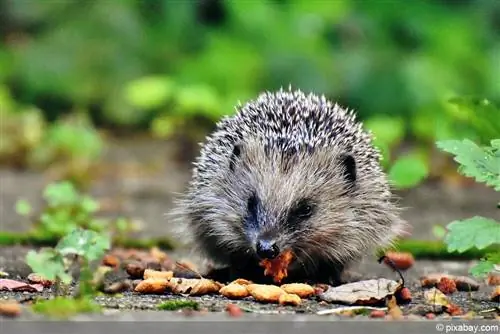
Once you have moved into the hedgehog house, the best care for a he althy hedgehog is to simply leave the hedgehog alone. When he wakes up in spring and moves out, the hedgehog house gets its spring cleaning: It's best to clean the hedgehog house in May, then hibernation is over, but the whelping season hasn't started yet.
To clean, please only use hot water without cleaning agents, then let the house dry out a little and then fill it with new nesting material. Your new garden resident may continue to use the hedgehog house to fill it with offspring. Then in the future it won't just be one hedgehog working for you, but a whole family of hedgehogs:
Hedgehogs are pretty useful in the garden
If the kids have been bothering you for a while, but you're not quite sure whether you really want to have fun with the hedgehog, here are a few arguments beyond all nature conservation and environmental protection -Considerations:
- Hedgehogs are a great cleaning crew that eat the things that first disturb the garden:
- Dead insects, worms and mice, even if they no longer smell very appetizing
- Beetles that would like to come into the house, larvae that would like to go into the kitchen
- Earwigs, centipedes, millipedes, bedbugs and black weevils
- Hedgehogs particularly like to eat the favorite enemy of many gardeners: snails, preferably fat slugs
- But also all other insects, any population that gets out of hand, is quickly brought back to normal by a hedgehog
- Since there are no vegetarians among hedgehogs, the fruit and vegetables in the garden are safe from them
If a hedgehog house is adopted and there may still be offspring, you no longer need to worry much about “biological plant protection”. By the way, hedgehogs prefer to settle in gardens where there is a colorful mix of ground cover plants instead of neatly raked areas, free-growing bird protection trees instead of precisely trimmed shrubs, and a bit of “chaotic nature” instead of perfect order. If there are wild corners with piles of leaves, bushes, stacks of old wood, you don't need to build a hedgehog house for them, the hedgehog can do that on its own in natural gardens.
Tip:
If hedgehogs wander around for days in frost instead of forgetting the world for a while in the hedgehog house, they probably haven't managed to eat their "hibernation weight" of around 500 g over the season. Such young hedgehogs should be handed over to the nearest hedgehog station to be nurtured; an older hedgehog can then still move into the hedgehog house.

